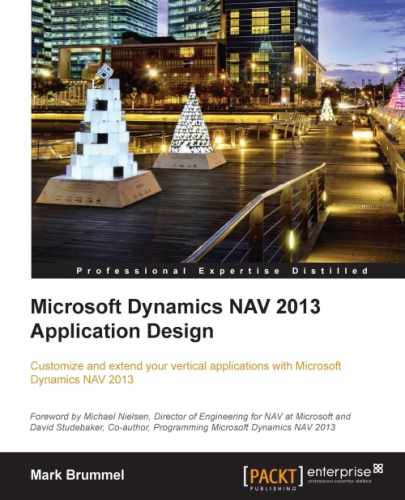- Microsoft Dynamics NAV 2013 Application Design
- Table of Contents
- Microsoft Dynamics NAV 2013 Application Design
- Credits
- Foreword
- About the Author
- Acknowledgments
- About the Reviewers
- www.PacktPub.com
- Preface
- 1. Introduction to Microsoft Dynamics NAV
- Versions and history
- What is this book about
- Setup versus customization
- The beauty of simplicity
- Design patterns
- Structure of this book
- The Role Tailored concept
- The building blocks
- Dynamics NAV in throughout supply chain
- Some basic design patterns
- Architectural design patterns
- Balancing
- Flow fields and flow filters
- More journals and entries
- Combining the journals into processes
- Other patterns
- Summary
- 2. A Sample Application
- 3. Financial Management
- 4. Relationship Management
- How companies work
- Customizing relationship management
- Summary
- 5. Production
- What is production?
- Basic production principles
- Getting started
- Assembling
- Design patterns
- The items
- Item costing
- Item tracking
- The bill of materials
- Calculating the standard cost
- Creating the inventory
- Adjusting cost item entries
- Posting inventory cost to G/L
- Check, check, and double check
- Recalculating the standard unit cost
- Assembly orders
- Check costing (again)
- Recalculating the unit cost (again)
- Standard cost worksheet
- Item Revaluation Journal
- The result
- Summarizing item costing in 10 steps
- Manufacturing
- Specialized production
- Assembling
- Vertical industry implementation
- Summary
- 6. Trade
- The process
- Sales and purchasing
- Inventory management
- Warehouse management
- Reservations
- Trade in vertical industries
- Summary
- 7. Storage and Logistics
- 8. Consulting
- 9. Interfacing
- Interface types
- Interfacing technologies
- Standard application interfaces
- Interface methodologies
- Interfacing into the future
- Summary
- 10. Application Design
- Application life cycle
- Design to use
- Design to Maintain
- Design to support
- Design to upgrade
- Design to perform
- Design to analyze
- Version and object management
- Development methodology
- The project
- Summary
- Application life cycle
- A. Installation Guide
- Index
In this chapter, we looked at how Microsoft Dynamics NAV can interface with other applications.
We discussed the basics of interfacing, import versus export, and data pulling versus data pushing. An interface can be executed manually or by a timer or event.
Microsoft Dynamics NAV supports a wide range of interfacing technologies, such as files, automation control, .NET, ODBC, ADO, and web services.
It is also possible to integrate using SQL Server technologies. The Application Server (NAS) is often used for interfacing with other systems, for example, using Microsoft Message Queuing or Active Data Objects (ADO).
The wide range of interfaces that come with the product have been discussed including all interfaces with Microsoft Office, Exchange, and SharePoint.
We designed and developed two business-to-business interfaces; one to import data manually from Microsoft Excel and the other to automatically import and export data to another database using ADO and a timer.
When designing an interface, reliability and traceability are the key elements. In the next chapter, we will talk about application design methodologies and principles.
-
No Comment
